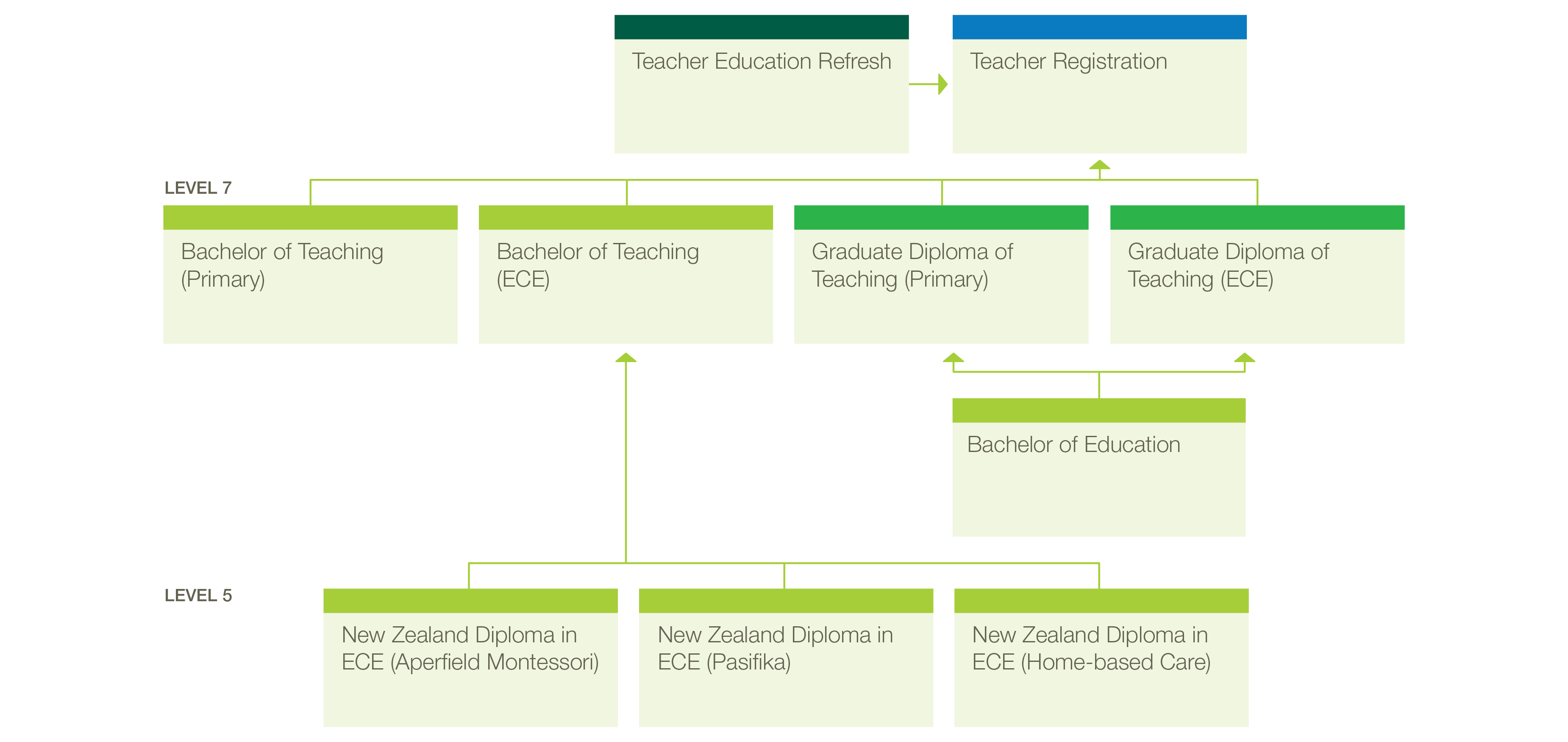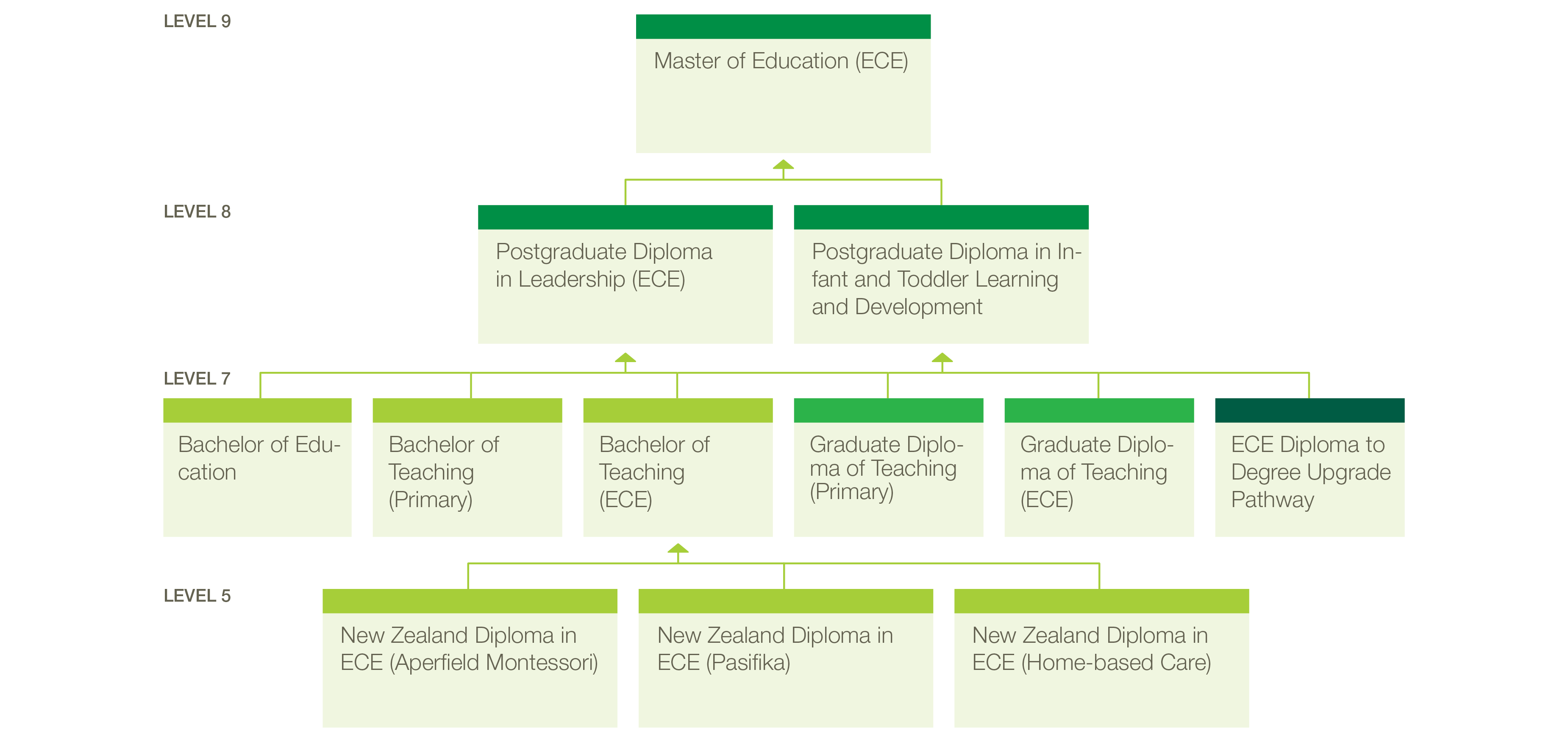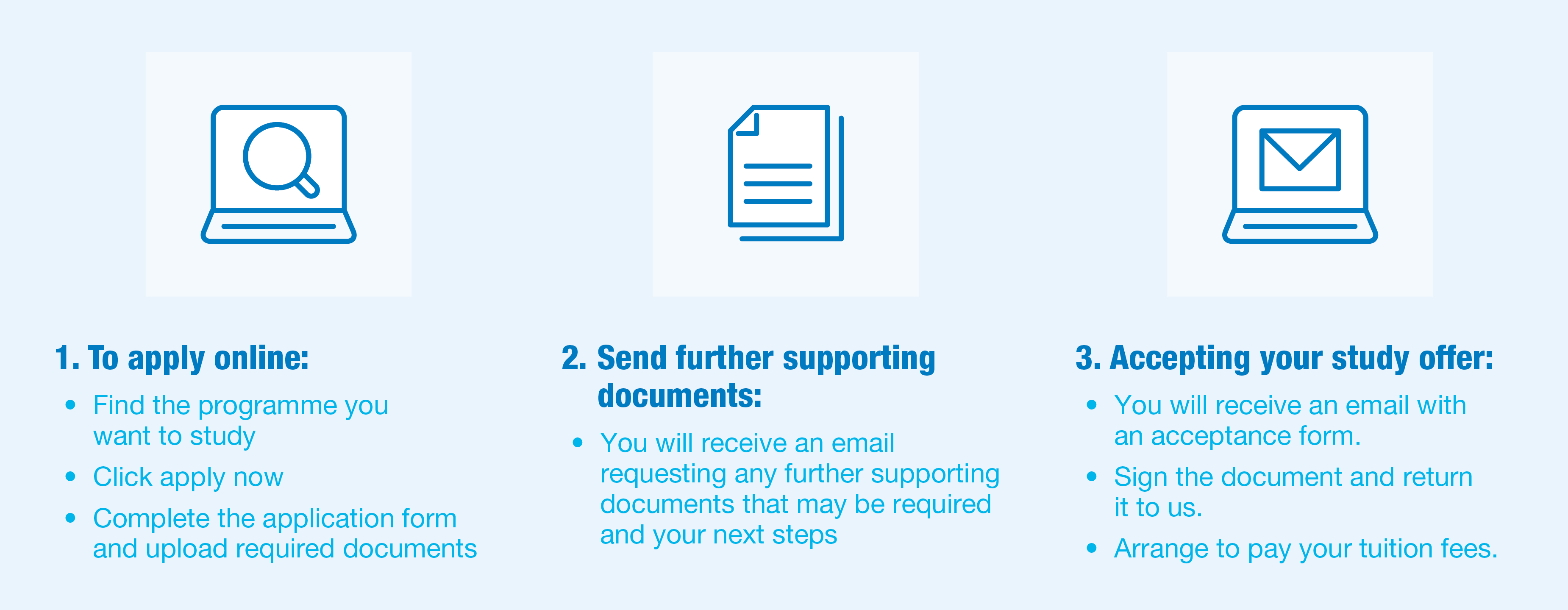Graduate Diploma of Teaching (Primary)
Pōkairua Paetahi Ako (Kura Tuatahi)

Level: 7
Credits: 150
Intakes: 1 per year
Duration:
Full-time: 1 year
Part-time: 2 years
Application closing dates:
Semester 1, 2026:
Domestic Students: 15 Dec 2025
International Students: 17 Nov 2025

Wherever you live, turn your degree into a career. Prepare to nurture and inspire the minds of young learners as a primary teacher in your community.
Gain real-life experience, professional knowledge, and bicultural skills to work with tamariki from years zero to ten (aged 5-15).
This programme will explore what it means to be a reflective, ethical, culturally responsive, and child-centred teacher in Aotearoa New Zealand. Through the graduate diploma you will build your understanding of the New Zealand curriculum, gain insights into children’s learning and development, and develop your knowledge of high-quality teaching practices.. Furthermore, you will gain the skills to embrace te reo me ōna tikanga Māori, Pacific culture, and the cultural identities of all tamariki you teach.
Note: International students are required to be in New Zealand to study this programme.
Teacher Registration Pathway
Upon completing this program, students will be eligible to apply for the Teacher Registration and Practicing Certificate from the Teaching Council of Aotearoa New Zealand.

- Full-time or part-time
- Online
- Field-based
- Practicum
- In-person Orientation
- Noho marae
This programme can be undertaken full-time for one year or part-time over two years.
A blend of online, face-to-face, and field-based learning will be used to deliver teaching and learning.
To set you up for success in the graduate diploma programme there is a three-day, in-person orientation at the start of semester one. In addition to this you will have an overnight noho marae experience in your local region in semester one and a one-day, online orientation at the start of semester two.
In addition to supervised practice in your local primary school, you will need to complete two teaching practicum placements, totalling 12 weeks in a different setting during the programme.
Alongside readily accessible support online, in-person support is available across our 11 Regional Education Centres. Simply locate the one nearest to you.
Assessment
This programme is assessed by internal assessment. Assessments are varied and include online conversation participation, essays, reports, PowerPoint presentations, multimedia presentations and other assessment types.
To be eligible for programme admission, you must:
-
Hold an equivalent NZQA Level 7 Bachelor’s Degree or higher (if gained overseas you may be required to have this assessed by NZQA).
-
Be at least 17 years of age if you are a domestic student; or 18 years of age if you are an international student.
-
Provide 2 written confidential referee reports.
Reports from family members or friends will not be accepted. -
Complete and pass a children’s worker safety check as required under the Children’s Act 2014.
-
Consent to and pass a police vetting check as required by the Children’s Act 2014.
-
Demonstrate competency in mathematics as per the Teaching Council’s mathematics/numeracy requirements. See: Mathematics/numeracy requirements for English medium primary Initial Teacher Education
-
Show proficiency in English as per the Teaching Council’s language competency requirements.
See: Language Competency Requirements
Applicants applying for the Initial Teacher Education (ITE) programmes and teacher registration can now use primary, secondary and tertiary schooling completed while living in the Pacific region, as evidence for demonstrating English language competency.
See: English Language Competency Pathway (ELCP) for Tagata o le Moana | Pacific Peoples -
Show a minimum level of proficiency in mathematics as required by the Teaching Council of Aotearoa New Zealand
-
Arrange to work or volunteer at a primary, intermediate or area school, supervised by a registered teacher with a full practising certificate, for a period of at least:
- 2 days a week; or
- 1 day a week, if you are studying part-time
Literacy and Numeracy Assessment
Applicants enrolling in a Primary Initial Teacher Education programme are required by the Teaching Council to meet specific mathematics entry requirements.
To help you feel confident and ready, we’re providing the guidance and support needed to build the skills required to successfully pass the LNAAT (Literacy and Numeracy for Adults Assessment).
We have made it simple to understand; review each section, use the resources and contact us for assistance as needed.
Changes to Initial Teacher
Student teachers enrolling in English-medium primary ITE programmes from 2025 onwards must demonstrate competency in mathematics by achieving the following on the Literacy and Numeracy for Adults Assessment Tool (LNAAT):
- a score of at least 690 (generally predictive of success at NCEA Level 2)
For more information, refer to the Teaching Council’s Website
Enrolling in 2026
- Graduate Diploma of Teaching (Primary)
Applicants are required to complete the LNAAT assessment to enrol in the programme.
This will be discussed as part of your interview process.
The LNAAT Assessment Practice
Completing an LNAAT Assessment Practice test can help you better understand your current literacy and numeracy levels.
To take a Literacy and Numeracy Adult Assessment Practice Test, use the link and passcode below:
-
Website: Literacy and numeracy for adults
-
Practice code: 4p73qq
The passcode may be used more than once.
Note: Grades and results from the practice assessment are not recorded. Please ensure you save a copy of your Assessment Report at the end of the assessment for your reference.
Understanding the LNAAT Report
The LNAAT assessment is designed to provide useful information to help you understand your numeracy profile. The LNAAT Individual Learner Report reflects your performance on the assessment you have just completed. It identifies your current step on the learning progression, provides a breakdown of your performance on each question, and offers additional information about the questions. The report also indicates the intent of each question, the aspect of the progression it relates to, and whether you answered it correctly.
This feedback will help you understand the areas where you need to focus your numeracy learning and practice.
Resources to help you understand the Individual Learner Report
-
Additional information on the dot plot section of the report can be downloaded here
The Adult Numeracy Progressions framework
The LNAAT is designed to match the six stages of numeracy progress for adult learners. The learning progressions offer a structured framework detailing what adult learners know and can do at each stage to develop their numeracy expertise. The framework can be used as a guide to help identify the next steps for adult learners. The numeracy learning progressions are organised into 3 connected areas that work together to support learning:
- Make Sense of Numbers to Solve Problems
- Reason Statistically
- Measure and Interpret Shape and Space
Supporting Resources
Refer to the Adult Numeracy Progression Framework Guide for further information on the progression steps within these areas. While these resources are not textbooks or teaching tools, they offer detailed information and examples that can help you understand the knowledge and skills required at each step.
For support with understanding your report, contact our Student Services at akomai@ecnz.ac.nz
Pathways Awarua
The Tertiary Education Commission has developed Pathways Awarua, an interactive and fun learning platform to support young and adult learners to strengthen their literacy and numeracy skills in contexts that are relevant to New Zealanders. Pathways Awarua offers learners six pathways including one for numeracy.
With over 180 modules covering a variety of topics, the numeracy pathway supports learners from step 2 to step 6 of the adult learning progressions. The modules are range from simple to more complex, allowing learners to progress at their own pace. Learners can:
-
freely move between different steps to find modules that meet their learning needs
-
choose from general, trade or service versions of the numeracy pathways
The lower-level modules focus on essential topics, such as interpreting numbers and working with simple fractions. As learners progress, they gain access to modules on rates, calculating GST, and understanding angle formulas.
How to access Pathways Awarua
There are two ways to log into Pathways Awarua:
| 1. Self-registration For those not enrolled with us or who have not completed the LNAAT Assessment |
2. Sign up code provided by Key Support person For those enrolled with us or have completed the LNAAT Assessment |
| - Visit: Pathways Awarua or Go Places Now - Fill in your details - Enter our join code: C139F5 - Click Register to complete your registration |
- Complete the LNAAT assessment - Receive or request an invitation link from your key support person. - Click register to complete your registration |
Resources
-
Number Facts Modules; designed to advance learners’ basic addition and multiplication facts.
What is a verified copy?
A verified copy is a photocopy of your original document signed as being a true and accurate copy by
a Justice of the Peace (JP), solicitor, church minister, kaumātua, police officer, school principal, Member
of Parliament or Te Rito Maioha teaching staff member. You can find a list of Justices of the Peace in the
Yellow Pages of the telephone book or at Royal Federation of NZ Justices’ Associations
Documents required to submit an application
1. Primary ID
You must supply a verified copy of one of the documents below:
- New Zealand Birth Certificate issued on or after 1 January 1998 carrying a unique identification number
- New Zealand Passport
- Overseas passport (must include relevant visa/residency permit)
- New Zealand Emergency travel document
- New Zealand refugee travel document
- New Zealand certificate of identity (issued under the Passports Act 1992 to non-NZ citizens who cannot obtain a passport from their country of origin)
- New Zealand certificate of identity (issued under the Immigration Act 1987 to people who have refugee status)
- New Zealand citizenship certificate
2. Secondary ID
You must supply a verified copy of one of the documents below:
- New Zealand Driver’s licence
- 18+ Card
- Community services card
- NZ student photo identification card – from another tertiary institution
- NZ employee photo identification card
- NZ electoral roll record
- Inland revenue number
- NZ utility bill, issued not more than six months earlier.
3. Evidence of qualification
This programme consists of 4 (30-credit) courses and 2 (15-credit) courses.
During this programme, you will study 6 courses:
| Becoming a Teaching Professional Through The Tens of Literacy, Mathematics, Health and Physical Education Te Kaiako Ringa Ngaio ki te Arotahi Pānuitanga, Pāngarau me te Whakapakari Tinana |
30 Credits |
| Becoming a Culturally Responsive Teacher Through The Lens of Social Science and The Arts Te Kaiako Whakaratarata Ahurea ki te Arotahi o te Pūtaiao Pāpori me te Mahi Toi |
30 Credits |
| Teacher as Weaver of Curriculum Through The Lens of Science and Technology Te Kaiako Raranga o te Marau Mātauranga: ki te Arotahi o te Pūtaiao me Hangarau |
30 Credits |
| The Teacher as a Leader of Learning and Problem Solver Te Kaiako he Kaiarataki te Akoranga me te Rapanga |
30 Credits |
| Practicum 1: Professional Experience Ritenga Ako: Wheako Ngaio Tahi |
15 Credits |
| Practicum 2: Professional Experience Ritenga Ako: Wheako Ngaio Rua |
15 Credits |
| Semester 1 2025 | |
|---|---|
| Start Date: | 27 January 2025 |
| In-person Orientation: | 22 - 24 January 2025 in Wellington |
| Noho Marae: | Week of 31 March 2025 |
| Mid Semester Break: | 14 – 27 April 2025 |
| Practicum 1: | 19 May – 22 June 2025 |
| End Date: | 22 June 2025 |
| Semester 2 2025 | |
| Start Date: | 14 July 2025 Online |
| Practicum 2 Starts: | 8 – 21 September 2025 (first two of seven weeks split across terms three and four) |
| Mid Semester Break: | 22 September – 5 October 2025 |
| Practicum 2 Continues: | 6 October – 9 November 2025 (last five weeks of seven, split across terms three and four) |
| End Date: | 7 December 2025 |
Fees cover all tuition costs, student guides, readings and Noho Marae.
All fees shown are for domestic students studying in 2025*:
| Full enrolment | 150 Credits | $9,100* |
| Part-time enrolment | 30 Credits | $1,820* |
| Part-time enrolment | 15 Credits | $910* |
| * Plus a compulsory field-based placement fee for all enrolments | $575 |
The field-based placement fee is a compulsory course cost for each year of the Graduate of Teaching (Primary).
The same fee applies for full-time and part-time enrolments.
Fees may be subject to late payment fees after the due date.
Enrolling as an international student, you will be subject to international fees.
Discover scholarships, grants and loans to finance your studies

School Onsite Training Programme
An initial teacher education programme designed to support and develop teacher trainees, ensuring they are well prepared for their teaching careers. Gain extensive hands-on classroom experience under the mentorship of skilled educators, while completing online coursework.


